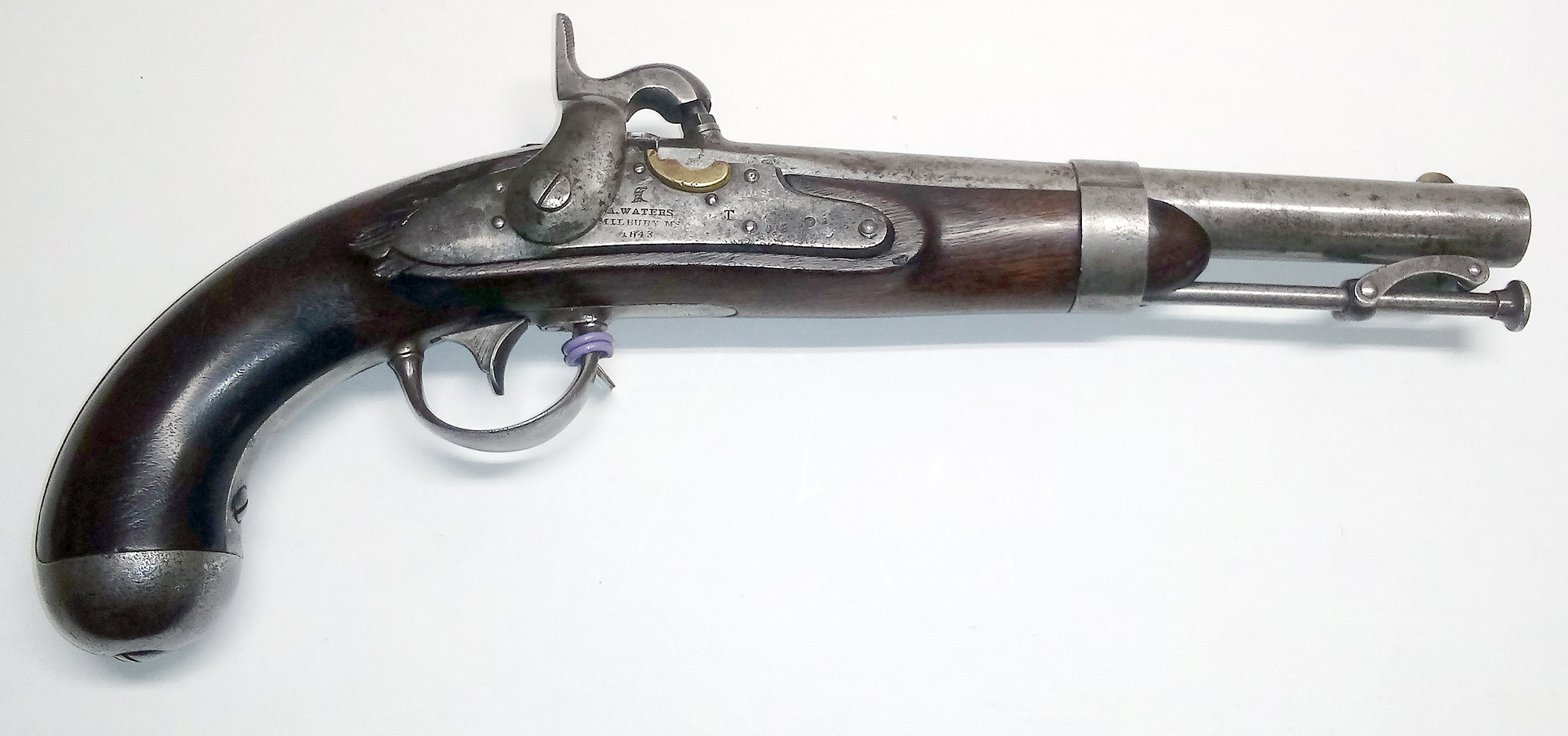site search
online catalog
1843 DATED U.S. 1836 PATTERN PISTOL BY ASA WATERS WITH PERCUSSION CONVERSION

$950.00 SOLD
Quantity Available: None
Item Code: 1000-425
The Model 1836 pistol was the culmination of decades of experiment, experience, and change. Reilly considered it to be the “finest military flintlock pistol ever produced,” with “trim lines, excellent balance and outstanding workmanship.” Iron-mounted, with swivel ramrod and long sidebar retaining the barrel band, these .54 caliber pistols were meant to be issued in pairs and carried by a dragoon in pommel holsters attached to the saddle.
This pistol is from the third U.S. contract of Asa Waters II, obtained in 1840, specifying 15,000 pistols to be delivered over five years. The lockplate has a very clear, correct, mark forward of the hammer: [eagle head] / A WATERS / MILLBURY MS / 1843.” (Asa Waters II died in 1841, but it was not until 1844 that the last 3,000 or so were marked by his son, “A.H. Waters & Co.”) Forward of this is stamped a “T.” Different letters are noted in this location on Waters’ pistols and are thought to be individual lock makers. The barrel shows a crisp “U.S. / NWP / P” inspector’s barrel proof mark on the left breech. Small individual letters, such as “H” and “R” are subinspector’s marks on the different parts.
The metal is smooth, with just a little pitting forward of the hammer, above the lockplate, likely from percussion firing. The metal is a muted silver gray with some darker gray spots mixed in. The rear of the hammer, however, shows some faded case color on the reverse. The conversion is a typical arsenal style cone-in-barrel, where the external flintlock parts were removed, holes plugged, the brass pan cut flush with the plate, and a new hammer installed. The touch hole was plugged and the breech raised by cold forging to give a seat to the nipple then drilled and threaded.
The wood has good color. There is a section chipped out at the rear and upper rear of the lockplate and a repaired crack below the rear. There are not many handling dings, though, and the wood shows visible ink cartouches on the left flat. The nipple is place and not battered. The brass front sight is present. The mechanics are good. This was the standard pistol for U.S. dragoons from 1836 to about 1845 and many likely remained in the holsters of volunteer cavalry during the Mexican War and militia units thereafter. In the 1850s the percussion alterations were usually sent to the various states for militia use and not a few of them saw service in the Civil War, particularly in the hands of early war southern cavalry. [sr] [ph:L]
DISCLAIMER: All firearms are sold as collector's items only - we do not accept responsibility as to the shooting safety or reliability of any antique firearm. All firearms are described as accurately as possible, given the restraints of a catalog listing length. We want satisfied customers & often "under" describe the weapons. Any city or state regulations regarding owning antique firearms are the responsibility of the purchaser. All firearms are "mechanically perfect" unless noted, but again, are NOT warranted as safe to fire.
~~~~~~~~~~~~~~~~~~~~~~~~~~~~~~~~~~~
THIS ITEM, AS WITH ALL OTHER ITEMS AVAILABLE ON OUR WEB SITE,
MAY BE PURCHASED THROUGH OUR LAYAWAY PROGRAM.
CLICK HERE FOR OUR POLICIES AND TERMS.
THANK YOU!
Inquire About 1843 DATED U.S. 1836 PATTERN PISTOL BY ASA WATERS WITH PERCUSSION CONVERSION
For inquiries, please email us at [email protected]
Most Popular
Historical Firearms Stolen From The National Civil War Museum In Harrisburg, Pa »
Theft From Gravesite Of Gen. John Reynolds »
Fine Condition Brass Infantry Bugle Insignia »
Selection Of Unframed Prints By Don Troiani »
Wonderful Condition Original Confederate-Manufactured Kepi For A Drummer Boy Or Child »
featured item
BUGLER’S SHELL JACKET IDENTIFIED TO PRIVATE WILLIAM BOPP, 2ND MISSOURI STATE MILITIA CAVALRY
Scarce Union Missouri cavalryman's jacket modified with Zouave style V-neck collar and custom-trimmed with bright yellow narrow cording at cuffs and on front, forming a semi-regulation rack pattern with looped cloverleaf ends. Seven-button front with… (591-04). Learn More »




















